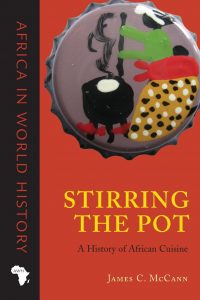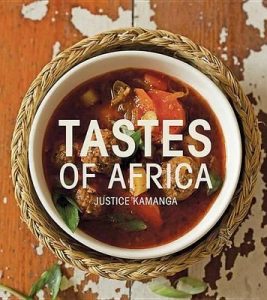Tasty Resources
By Regan Hardy • April 30, 2018
Here is a non-exhaustive list of delicious resources for those wishing to learn more about Cameroonian cuisine. Happy cooking!
Mbaku, John Mukum. “Cuisine and Traditional Dress.” Culture and Customs of Cameroon, edited by Toyin Falola, Greenwood Press, 2005, pp. 121-137.
Full of facts about rich cultural tradition, Culture and Customs of Cameroon provides readers with introductory information about the region’s varied cuisine. Along with basic ingredients for most Cameroonian dishes, one will also find explanations of popular restaurant beverages and dishes for social events, such as palm wine and fufu, a dish made by creating dumplings from coco-yams.
Despite this article’s dense appearance and largely scientific focus, the editors include a wonderful resource of regional cuisine differences in Cameroon. From cassava leaves and palm nuts in east Cameroon to plantains and hunted insects in the north, recipes using harder-to-find ingredients will be made simple with these specific lists of national delicacies.

McCann, James. Stirring the Pot: A History of African Cuisine. Ohio University Press, 2009.
James McCann delves into West African culinary values and popular recipes to teach the reader to cook with unfamiliar ingredients. Peruse the chapters about starches and stews to learn more aboutthe lush, diverse cuisine enjoyed in Cameroon.
Darlene. “Journey to Cameroon.” International Cuisine.
The specificity and beautiful photography of this website’s posting on Cameroon could draw any reader in, even though the true headliner of the page is the recipes the writer has remade in a Western kitchen. Author Darlene provides a truly accessible approach to Cameroonian dishes while remaining true to the heart of West African cuisine.
Wrapson, Pete. “Cameroon: Tracing African Food Roots.” Jamie Oliver.
This article’s main aim, to reveal the rich history layered beneath modern Cameroonian recipes, is immediately clear to the reader through gorgeous, detailed photos of different vegetables commonly used in West African cuisine. Wrapson tells the story of cooking in Cameroon to inspire the reader to recreate the same soulful principles in the kitchen.
Carman, Tim. “The Oily Charms of West African Cuisine.” The Washington Post, 2012.
Although Tim Carman offers a blunt and honest American point of view when visiting a local West African restaurant, this attitude allows readers to understand the cultural differences between Cameroon and the United States when searching for resources for ingredients. Cameroonian tradition includes staying at home and cooking instead of dining at restaurants, which can encourage the reader to spend time with family and cook with love.

The brainchild of author Imma, this colorful blog provides many Afro-Caribbean recipes and introductions to homestyle African cooking, but several posts feature prominent Cameroonian dishes. Imma gives the reader an easy-to-understand look into recipes that would seem in-depth from first glance.
Kamanga, Justice. Tastes of Africa. Struike Lifestyle, 2010.
Author Justice Kamanga puts together a wildly diverse cookbook filled with recipes from all over Africa. However, Kamanga’s Cameroonian staples like fufu and jolof, a dish made with rice for holidays, shine when one is looking for a simple, tasty West African meal.
Preciou s Kitchen. YouTube, uploaded by Precious Nkeih.
s Kitchen. YouTube, uploaded by Precious Nkeih.
Author Precious Nkeih, born in Cameroon but currently residing in the United States, operates a YouTube channel with many informative and inviting videos of delicious Cameroonian dishes. Check out her recipes to experience a wonderful introduction into the world of African cuisine.